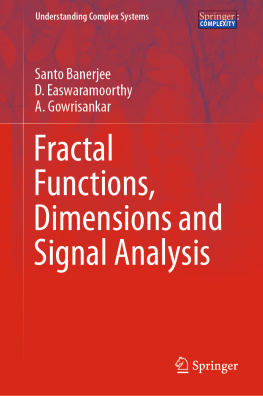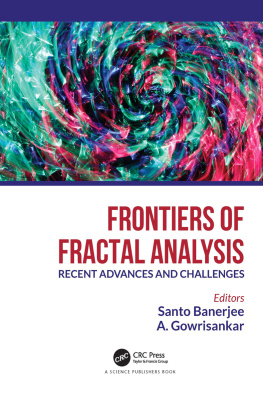Santo Banerjee - Fractal Functions, Dimensions and Signal Analysis
Here you can read online Santo Banerjee - Fractal Functions, Dimensions and Signal Analysis full text of the book (entire story) in english for free. Download pdf and epub, get meaning, cover and reviews about this ebook. year: 2020, publisher: Springer International Publishing, genre: Computer. Description of the work, (preface) as well as reviews are available. Best literature library LitArk.com created for fans of good reading and offers a wide selection of genres:
Romance novel
Science fiction
Adventure
Detective
Science
History
Home and family
Prose
Art
Politics
Computer
Non-fiction
Religion
Business
Children
Humor
Choose a favorite category and find really read worthwhile books. Enjoy immersion in the world of imagination, feel the emotions of the characters or learn something new for yourself, make an fascinating discovery.
- Book:Fractal Functions, Dimensions and Signal Analysis
- Author:
- Publisher:Springer International Publishing
- Genre:
- Year:2020
- Rating:5 / 5
- Favourites:Add to favourites
- Your mark:
- 100
- 1
- 2
- 3
- 4
- 5
Fractal Functions, Dimensions and Signal Analysis: summary, description and annotation
We offer to read an annotation, description, summary or preface (depends on what the author of the book "Fractal Functions, Dimensions and Signal Analysis" wrote himself). If you haven't found the necessary information about the book — write in the comments, we will try to find it.
Fractal Functions, Dimensions and Signal Analysis — read online for free the complete book (whole text) full work
Below is the text of the book, divided by pages. System saving the place of the last page read, allows you to conveniently read the book "Fractal Functions, Dimensions and Signal Analysis" online for free, without having to search again every time where you left off. Put a bookmark, and you can go to the page where you finished reading at any time.
Font size:
Interval:
Bookmark:

Springer Complexity is an interdisciplinary program publishing the best research and academic-level teaching on both fundamental and applied aspects of complex systemscutting across all traditional disciplines of the natural and life sciences, engineering, economics, medicine, neuroscience, social and computer science.
Complex Systems are systems that comprise many interacting parts with the ability to generate a new quality of macroscopic collective behavior the manifestations of which are the spontaneous formation of distinctive temporal, spatial or functional structures. Models of such systems can be successfully mapped onto quite diverse real-life situations like the climate, the coherent emission of light from lasers, chemical reaction-diffusion systems, biological cellular networks, the dynamics of stock markets and of the internet, earthquake statistics and prediction, freeway traffic, the human brain, or the formation of opinions in social systems, to name just some of the popular applications.
Although their scope and methodologies overlap somewhat, one can distinguish the following main concepts and tools: self-organization, nonlinear dynamics, synergetics, turbulence, dynamical systems, catastrophes, instabilities, stochastic processes, chaos, graphs and networks, cellular automata, adaptive systems, genetic algorithms and computational intelligence.
The three major book publication platforms of the Springer Complexity program are the monograph series Understanding Complex Systems focusing on the various applications of complexity, the Springer Series in Synergetics, which is devoted to the quantitative theoretical and methodological foundations, and the Springer Briefs in Complexity which are concise and topical working reports, case studies, surveys, essays and lecture notes of relevance to the field. In addition to the books in these two core series, the program also incorporates individual titles ranging from textbooks to major reference works.
Indexed by SCOPUS, INSPEC, zbMATH, SCImago.
More information about this series at http://www.springer.com/series/5394

This Springer imprint is published by the registered company Springer Nature Switzerland AG
The registered company address is: Gewerbestrasse 11, 6330 Cham, Switzerland
The traditional interpolation techniques generate smooth or piecewise differentiable interpolation function, despite the data points being irregular. Nevertheless, most of the natural objects such as lightning, clouds, mountain ranges, and wall cracks have irregular and complex structures in which Euclidean geometry cannot be applied successfully to describe them, since Euclidean geometry which deals with regular objects and functions is used to approximate the data obtained from the realistic environment. Hence, there is a need of a nonlinear tool in the approximation theory to resolve these problems. Barnsley invented the fractal interpolation function based on the theory of iterated function systems, which precisely suited for the approximation of naturally occurring functions which possess some kind of self-similarity under magnification.
In the approximation theory, Fractal Interpolation Functions (FIF) play a vital role. It is important and necessary to discuss the variance ratio of such functions. But they are often nowhere differentiable, everywhere continuous. Hence, FIFs are sophisticated in approximating the rough curve and precisely reconstructing the naturally occurring functions when compared with classical interpolants. Nevertheless, a smooth curve is needed to approximate some kind of functions which include self-similarity under magnification. Hence, Barnsley presented the indefinitely integrated fractal interpolation function generated from some special type of the iterated function system which interpolates a certain set of data, and the integral of the fractal interpolation function retains its properties. Further, they have explored the construction of n-times frequently differentiable FIF when the derivative values reaching up to the nth order are available at the initial endpoint of the interval. The examples of differentiable functions cannot actually be considered as fractals, but they retain the name fractal interpolation function because of the flavor of the scaling in the equation and the HausdorffBesicovitch dimension of their graphs are non-integer. Due to the sophisticated usage of such fractal interpolants in nonlinear approximation, there are continuous efforts have extended on fractal interpolation functions.
Font size:
Interval:
Bookmark:
Similar books «Fractal Functions, Dimensions and Signal Analysis»
Look at similar books to Fractal Functions, Dimensions and Signal Analysis. We have selected literature similar in name and meaning in the hope of providing readers with more options to find new, interesting, not yet read works.
Discussion, reviews of the book Fractal Functions, Dimensions and Signal Analysis and just readers' own opinions. Leave your comments, write what you think about the work, its meaning or the main characters. Specify what exactly you liked and what you didn't like, and why you think so.












